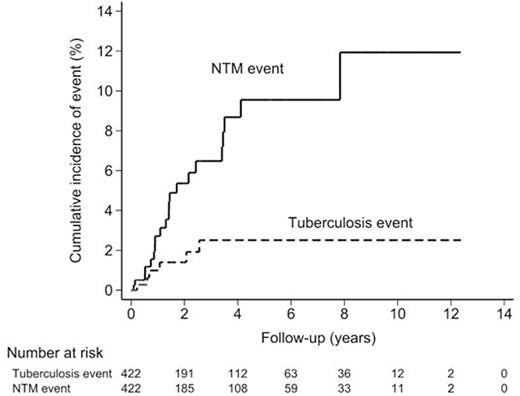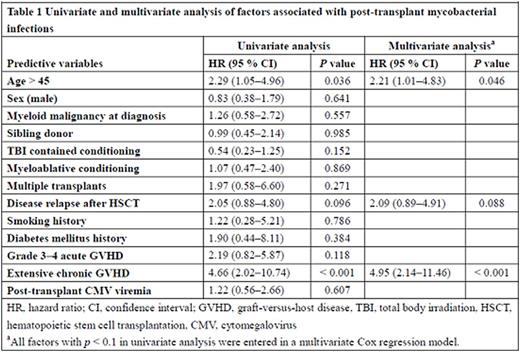Abstract
Background
Mycobacterial infection is an important and potentially life-threatening complication of patients receiving organ transplantations. Notably, for the recipients of allogeneic hematopoietic stem cell transplantation (HSCT), there are few supporting results to explore post-transplant mycobacterial infections. Taiwan is a high endemic area of the infection. We therefore aim to investigate the incidence, risk factors, and survival of post-transplant mycobacterial infections, including mycobacterium tuberculosis (MTB) and nontuberculous mycobacterium (NTM).
Patients and Methods
We included in this study 422 adult patients undergoing allogeneic HSCT at an Asian tertiary medical center between January 2003 and December 2013. A total 26 subjects who developed post-transplant mycobacterial infections were identified. Risk factors, clinical features, and survival for post-transplant mycobacterial infections in recipients of HSCT were collected and analyzed.
Results
Post-transplant mycobacterial infections occurred in 26 (6.2%) of 422 HSCT patients. Two-year cumulative incidences in MTB and NTM were 1.4 % and 5.4%. In the multivariate analysis, being age > 45 years (adjusted HR 2.21, 95% CI 1.01-4.83)) and extensive chronic graft-versus-host disease (cGVHD) (adjusted HR 4.95, 95% CI 2.14-11.46) were identified as independent risk factors of post-transplant mycobacterial infections. There was a trend as a risk factors in relapsed patients (P=0.088). For patients with cGVHD, there was a significant difference of post-transplant survival between mycobacterial infections and none (median: 6.82 months versus not reached, P=0.036). Pneumonia with or without other infections contributed most to mortality (n = 11, 42.3%).
Conclusion
The 2-year cumulative incidence is higher in NTM (5.4%) than TB (1.4%) in recipients of allogeneic HSCT. Patients with age > 45 years, and extensive cGVHD are at risk of mycobacterial infections. Poor post-transplant survival in cGVHD patients developed mycobacterial infections and 42.3% patients in our study died of pneumonia. Once a high-risk group is identified, much effort is required to target new approaches for prevention, early detection and treatment of infections.
No relevant conflicts of interest to declare.
Author notes
Asterisk with author names denotes non-ASH members.




This feature is available to Subscribers Only
Sign In or Create an Account Close Modal